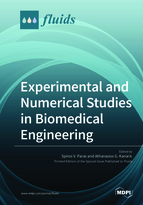Experimental and Numerical Studies in Biomedical Engineering
A special issue of Fluids (ISSN 2311-5521).
Deadline for manuscript submissions: closed (31 May 2019) | Viewed by 37868
Special Issue Editors
Interests: multiphase flows; biomedical engineering; CFD; non-intrusive measuring techniques; process equipment design
Interests: advanced computational techniques; CFD; microdevices; heat transfer; inkjet systems
Special Issues, Collections and Topics in MDPI journals
Special Issue Information
Dear Colleagues,
The term ‘biomedical engineering’ refers to the application of the principles and problem-solving techniques of engineering to biology and medicine. Biomedical engineering is an interdisciplinary branch, as many of the problems health professionals are confronted with have traditionally been of interest to engineers because they involve processes that are fundamental to engineering practice. Biomedical engineers employ common engineering methods to comprehend, modify, or control biological systems, and to design and manufacture devices that can assist in the diagnosis and therapy of human diseases.
This Special Issue of Fluids aims to be a forum for scientists and engineers from academia and industry to present and discuss recent developments in the field of biomedical engineering. We invite papers that tackle, either numerically (Computational Fluid Dynamics studies) or experimentally, biomedical engineering problems, ranging from the fundamental understanding of fluid flows in biological systems to the design and practical application of medical devices and systems. Contributions may focus on problems associated with subjects that include (but are not limited to): hemodynamical flows, arterial wall shear stress, respiratory mechanics and gas exchange, targeted drug delivery, bio-materials, design of medical devices.
Prof. Spiros V. Paras
Dr. Athanasios G. Kanaris
Guest Editors
Manuscript Submission Information
Manuscripts should be submitted online at www.mdpi.com by registering and logging in to this website. Once you are registered, click here to go to the submission form. Manuscripts can be submitted until the deadline. All submissions that pass pre-check are peer-reviewed. Accepted papers will be published continuously in the journal (as soon as accepted) and will be listed together on the special issue website. Research articles, review articles as well as short communications are invited. For planned papers, a title and short abstract (about 100 words) can be sent to the Editorial Office for announcement on this website.
Submitted manuscripts should not have been published previously, nor be under consideration for publication elsewhere (except conference proceedings papers). All manuscripts are thoroughly refereed through a single-blind peer-review process. A guide for authors and other relevant information for submission of manuscripts is available on the Instructions for Authors page. Fluids is an international peer-reviewed open access monthly journal published by MDPI.
Please visit the Instructions for Authors page before submitting a manuscript. The Article Processing Charge (APC) for publication in this open access journal is 1800 CHF (Swiss Francs). Submitted papers should be well formatted and use good English. Authors may use MDPI's English editing service prior to publication or during author revisions.
Keywords
- Blood flow
- Cardiovascular diseases
- Bypass grafting hemodynamics
- Pulmonary aerosol transport
- CFD simulations
- FSI
- PIV
- Arterial wall shear stress
- Drug delivery
- Biomaterials







